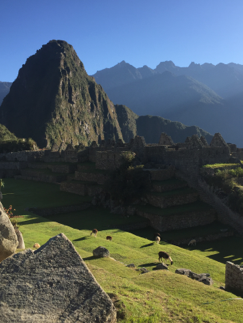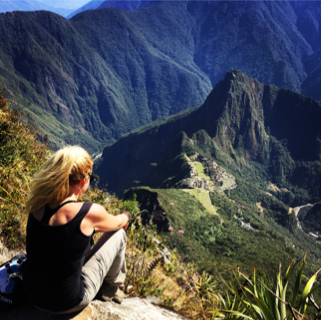Adventures in Peru- the Inca Trail to Machu Picchu
- thebrieadventure

- Jan 13, 2018
- 6 min read

One of my big bucket list items was to visit the Seven Wonders of the World before turning 25. Machu Picchu which was one of the wonders that I was particularly excited to visit because of its mysterious history and remote location. As my first trip to South America, Peru was a great introduction to all of the untouched natural beauty on the continent. I will make note that I went on this trip immediately following EDC (Electronic Daisy Carnival) a three-day music festival in Las Vegas where I slept a total of perhaps 7 hours and while admittedly, that was poor planning on my part, nothing could damper the excitement for this trip!
This was also my first time using Viator to book a multi-day trip, but since it saved me the headache of navigating the internet and trying to find where to do a variety of activities and locate the proper trails, it was worth a try. Two friends went on the trip and we joined a larger group that turned out to be an outstanding hodge-podge of travelers that we became quick friends with while traipsing along the Inca trail. On the first day of the trip we got dropped off in Santa Maria where we picked up gear from the shadiest looking warehouse possible on the abandoned edge of a random town to go white water rafting. It felt like the opening scene of a thriller where you are questioning if anyone is actually stupid enough to go into such a run-down building, but after an hour of anxious waiting, a bus actually picked us up and took us to a river. After rafting the class III and IV rapids until sunset we hiked an hour up the mountain to our first nights’ accommodation in the dark, straining to keep our guide in sight since our flashlights were buried in our packs. When he warned us to keep an eye out for Anacondas on the trail and to watch the cliff edges as we climbed higher, we decided to go ahead and use the remaining battery on our iphones to have some light. Throughout the trip we had the chance to sample many of the local dishes and drinks. Yet despite our best efforts to try the local cuisine of deep fried cuy- aka guinea pig, we only found other local eats such as ceviche and anticuchos (skewers of meat). No restaurant advertised cut on its menu even though it is widely considered to be a staple of the Peruvian diet. However, that first night after our long night climb, we were served dinner in a kitchen with about a hundred of the little guys cruising the room so I am not convinced of our guides assurance that chicken was served.
The next morning we woke up early and got a brief lecture from our guide about the local fruits and floral before he painted our faces using some the seeds and juice from inside one of the fruits. We ate a hearty breakfast and started the trek from Santa Monica to Santa Teresa and along the way we saw a variety of small coffee plantations and fruit trees. The ecosystem is a part of the high montain forest and is one of the richest in biodiversity in the tropics according to our guide. We spent the entire day on the trail hiking past waterfalls and crossing suspension bridges and rivers until arriving at the Cocalmayu hot springs where we had the chance to relax and soak in the water surrounded by some gorgeous mountains. That night we were given a full traditional meal at one of the local restaurants. While the food was quite tasty the highlight came a bit later on though after dinner when we were given generous samples of the local tequila. We all decided to keep going and went to a local bar that was completely empty so we immediately took it over. The next few hours of drinking and dancing were an absolute blast, so it was a bit of a surprise in the morning when everyone woke up on time and was ready to continue the trek.
The next morning we started the day out with zip lining. The level of entertainment provided by most of the activities on this trip was elevated by the sheer lack of regulations and the zip lining was certainly no exception. My first time zip lining I thought that it was possibly the most boring activity I had ever done and had no interest in doing it again. However, the experience in Peru was nothing like when I did it in West Virginia. Instead of crossing the wires slowly and in a very controlled manner, we were given heavy duty gloves that we were supposed to grab the wire to slow ourselves down, which we certainly did not do well. Instead we went flying across the ravines and the river and some of us came in a bit too hot at the end, knocking into those on the other side. Afterwards we continued on to a lovely afternoon nap in hammocks before beginning the final stretch to the town of Aguas Calientes below the mountain of Machu Picchu.
Following lunch and several rounds of pisco sours later, our troupe made it to the little town of Aguas Calientes which looks like it is straight out of a novel with a picturesque stream flowing down the middle of the quaint town that is tucked away between two mountains. We prepped all our gear the night before because seeing the sunrise at the top was highly recommended by our guide. There is a bridge that serves as a gate to the bottom of the mountain that opens at 5 am, but the queue started forming around 4:30 am, so he told us that it was important to get there early.
As soon as the bridge opened, it was literally a mad dash up the mountain for about 45min as the other climbers were also competing for a clear shot of Machu Picchu. While it is a simple climb with relatively even stairs, it is narrow and a direct climb straight up. Although we went in June, our group still packed light jackets and warming layers for the top. Even though we started in tank tops and light hiking pants, by the time that we had finished the race to the top we were cold, sweaty, and very thankful for warm clothes. Shortly after arriving and getting tickets at the entrance, we watched the stunning sunrise at the top in the quiet morning which was worth every sweaty step.
Once inside the area though, tourists are free to explore to their hearts content the truly breathtaking Machu Picchu! Our guide gave us a brief history of the site explaining that the Incas built the city in the classical Inca style around 1450 but later abandoned it during the Spanish Conquest. Despite its close proximity to Cusco, the Spanish never found Machu Picchu which greatly helped preserve it and prevented it from being plundered. As centuries passed though the jungle overgrew the site and only the locals in the surrounding area knew of it until in the early 20th century. A local farmer led an American historian who was searching for the forgotten Incan capital to the grounds and it was officially rediscovered. Today the extensive restorative and reconstructive efforts provides visitors a sense of what it used to look like as many of the walls and surrounding terraces have been rebuilt.
There are two additional mountains inside Macchu Pichu- Huayna Picchu and Machu Picchu Mountain that are possible to climb, but should be booked in advance during the peak season. The first is the smaller mountain of the two but has a more difficult trail while the second is significantly higher and takes nearly twice the time. Since I was climbing with two other Marines (effectively turning it into a race up the mountain) we completed the estimated two-hour climb up the Machu Picchu Mountain in just under an hour. Even though I was drenched in sweat and out of breath, it was worth every strenuous second. The outlook from the peak offered a stunning vantage point of the sprawling ruins below. Thankfully the three of us amigos had planned ahead for this portion and hiked up Cusquenas, one of the local cervezas, to enjoy a cold one with a view!








































Comments